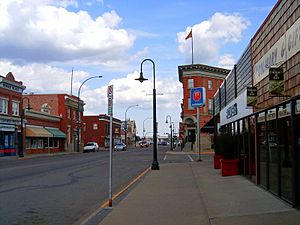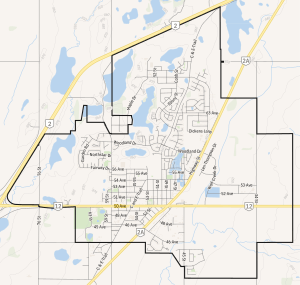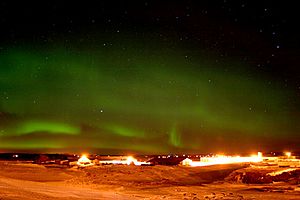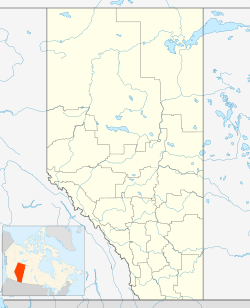Lacombe, Alberta facts for kids
Quick facts for kids
Lacombe
|
|||||
|---|---|---|---|---|---|
|
City
|
|||||
| City of Lacombe | |||||

Main Street
|
|||||
|
|||||
| Motto(s):
"People, Pride, Progress"
|
|||||

City boundaries
|
|||||
| Country | Canada | ||||
| Province | Alberta | ||||
| Planning region | Red Deer | ||||
| Municipal district | Lacombe County | ||||
| Incorporated | |||||
| • Village | July 28, 1896 | ||||
| • Town | May 5, 1902 | ||||
| • City | September 5, 2010 | ||||
| Area
(2021)
|
|||||
| • Land | 20.59 km2 (7.95 sq mi) | ||||
| Elevation | 855 m (2,805 ft) | ||||
| Population
(2021)
|
|||||
| • Total | 13,396 | ||||
| • Density | 650.8/km2 (1,686/sq mi) | ||||
| • Municipal census (2019) | 13,985 | ||||
| • Estimate (2020) | 14,109 | ||||
| Demonym(s) | Lacombian | ||||
| Time zone | UTC−7 (MST) | ||||
| • Summer (DST) | UTC−6 (MDT) | ||||
| Forward sortation area |
T4L
|
||||
| Area code(s) | +1-403 | ||||
| Highways | Highway 2A Highway 12 |
||||
Lacombe (pronounced lə-KOHM) is a city in central Alberta, Canada. It's about 25 kilometers (15 miles) north of Red Deer, which is the closest big city. It's also about 125 kilometers (78 miles) south of Edmonton, a larger metropolitan area. Lacombe is located in the rolling parkland of central Alberta. This area is between the Rocky Mountains to the west and the flatter Alberta prairies to the east.
Lacombe officially became Alberta's 17th city on September 5, 2010.
Contents
Discovering Lacombe's Past
Lacombe is named after Albert Lacombe (1827–1916). He was a French-Canadian Roman Catholic missionary. A missionary is someone who travels to spread their religious beliefs. Father Lacombe lived among and taught the Cree and Blackfoot First Nations in western Canada.
He is remembered for helping the Cree and Blackfoot nations make peace. He also helped arrange for the Canadian Pacific Railway to be built through Blackfoot land. In 1885, he convinced the Blackfoot leader Crowfoot not to join the North-West Rebellion. The Lacombe Police Service has been keeping the community safe since 1900.
Early Settlers and Growth
The first person to settle permanently in the area was Ed Barnett in 1883. He was a retired member of the North-West Mounted Police (NWMP). The NWMP was an early police force in Canada. Barnett set up a "stopping house" for travelers. A stopping house was like a small inn where people could rest during their journeys. He built it on land given to him for his police service.
His family and friends moved from Ontario, and the community started to grow. The stopping house became known as Barnett's Siding.
The Canadian Pacific Railway arrived in the area in 1891. This made it easier for people to travel to and settle in Lacombe. By 1893, the downtown area was planned out. Lacombe became a village in 1896 and then a town in 1902.
In 1907, the Canadian government opened an experimental farm here. This farm researched how to grow grains and raise livestock. The president of the C.P.R., William Van Horne, renamed Barnett's Siding to Lacombe to honor Father Lacombe.
Lacombe's Geography and Climate
Lacombe has a humid continental climate. This means it has warm summers and cold, snowy winters.
| Climate data for Lacombe | |||||||||||||
|---|---|---|---|---|---|---|---|---|---|---|---|---|---|
| Month | Jan | Feb | Mar | Apr | May | Jun | Jul | Aug | Sep | Oct | Nov | Dec | Year |
| Record high °C (°F) | 15.6 (60.1) |
18 (64) |
20.6 (69.1) |
30.6 (87.1) |
33.3 (91.9) |
37.8 (100.0) |
38.3 (100.9) |
36.8 (98.2) |
35 (95) |
32.2 (90.0) |
23.3 (73.9) |
17.8 (64.0) |
38.3 (100.9) |
| Mean daily maximum °C (°F) | −6.7 (19.9) |
−4.3 (24.3) |
2.1 (35.8) |
10.9 (51.6) |
17.1 (62.8) |
20.4 (68.7) |
22 (72) |
21.6 (70.9) |
16.6 (61.9) |
11.4 (52.5) |
0.5 (32.9) |
−5.5 (22.1) |
8.8 (47.8) |
| Daily mean °C (°F) | −12.3 (9.9) |
−10.2 (13.6) |
−3.8 (25.2) |
4.3 (39.7) |
10.1 (50.2) |
13.9 (57.0) |
15.4 (59.7) |
14.7 (58.5) |
9.8 (49.6) |
4.5 (40.1) |
−4.9 (23.2) |
−11 (12) |
2.6 (36.7) |
| Mean daily minimum °C (°F) | −17.9 (−0.2) |
−16 (3) |
−9.6 (14.7) |
−2.3 (27.9) |
3.1 (37.6) |
7.2 (45.0) |
8.8 (47.8) |
7.8 (46.0) |
3 (37) |
−2.5 (27.5) |
−10.3 (13.5) |
−16.4 (2.5) |
−3.8 (25.2) |
| Record low °C (°F) | −48.9 (−56.0) |
−45 (−49) |
−41.1 (−42.0) |
−32.2 (−26.0) |
−12.2 (10.0) |
−5.6 (21.9) |
−1.1 (30.0) |
−5.5 (22.1) |
−14.4 (6.1) |
−26.5 (−15.7) |
−37.5 (−35.5) |
−49.4 (−56.9) |
−49.4 (−56.9) |
| Average precipitation mm (inches) | 17.5 (0.69) |
10.8 (0.43) |
12.8 (0.50) |
21 (0.8) |
55.6 (2.19) |
75.7 (2.98) |
89.4 (3.52) |
70.8 (2.79) |
47.3 (1.86) |
16.6 (0.65) |
14 (0.6) |
14.5 (0.57) |
446 (17.6) |
| Source: Environment Canada | |||||||||||||
People of Lacombe
In the 2021 Census, Lacombe had a population of 13,396 people. A census is an official count of a population. This was a small increase from its population of 13,057 in 2016. Lacombe is growing!
Lacombe's Economy
Lacombe is in a very fertile valley between Calgary and Edmonton. This means its economy relies a lot on farming. The city also has a strong oil and gas industry.
Lacombe Research and Development Centre
The Lacombe Research and Development Centre (LRDC) is part of a national network of agricultural research centers. These centers are funded by the Canadian government. They help develop Canada's large food industry.
The LRDC does research on field crops and raising livestock. Livestock are farm animals like cows and pigs. The center focuses on improving red meat quality and safety. They also work on sustainable ways to grow crops and raise animals. They develop crop types that grow well in central Alberta's short growing season.
The LRDC created a special type of pig called the Lacombe hog. Work on this pig started in 1947 and took 12 years. The Lacombe hog is known for being well-suited to the tough prairie environment. It was the first livestock breed ever developed in Canada!
Len Thompson Manufacturing Plant
Since 1958, Lacombe has been home to the Thompson-Pallister Bait Co. This is a family business that has been around for four generations. They make fishing lures, including the famous Len Thompson Fishing Spoon. They also own and make Northern King fishing lures and True North brand wood chips.
Sports and Recreation
The Lacombe Generals hockey team played in the Gary Moe Auto Group Sportsplex from 2016 to 2019.
Learning in Lacombe

Lacombe has a Seventh-day Adventist university called Burman University. It was started near Lacombe in 1909 and is still open today.
The city has many public schools that are part of the Wolf Creek Public School Division. These include École Secondaire Lacombe Composite High School for grades 10-12. Other public schools are École J.S. McCormick School (Kindergarten-Grade 3), École Lacombe Upper Elementary School (Grades 4-6), Terrace Ridge School (Kindergarten-Grade 7), École Lacombe Junior High School (Grades 7-9), and Lacombe Outreach School.
Lacombe also has private schools like Lacombe Christian School (Preschool-Grade 9), Central Alberta Christian High School (Grades 10-12), College Heights Christian School (Kindergarten-Grade 9), and Parkview Adventist Academy (Grades 10-12). There is also Father Lacombe Catholic School (Kindergarten-Grade 9).
Lacombe's Unique Buildings
Lacombe's main street has been used in movies because it looks like a town from the early 1900s. The street is lined with beautiful Edwardian buildings that have been restored.
One of the most famous buildings is the Flatiron Building. Today, it is home to the Flatiron Museum and Interpretive Centre. Downtown Lacombe also has the Lacombe Blacksmith Shop Museum. It claims to be the oldest working blacksmith shop in Alberta.
Lacombe's oldest building is the Michener House Museum and Archives, built in 1894. This house was the birthplace of Roland Michener. He was Canada's Governor General from 1967 to 1974. A Governor General is the King or Queen's representative in Canada.
Famous People from Lacombe
- Roland Michener was a very important person from Lacombe. He served as Governor General of Canada from 1967 to 1974. A local museum and park are named after him.
- Irene Parlby helped start the first women's group of the United Farmers of Alberta in 1913. In 1921, she was elected to the Alberta Legislature. She was the first woman Cabinet minister in Alberta. Parlby was one of the Famous Five. This group fought a court battle to prove that women were "qualified Persons" and could serve in the Senate of Canada. She worked hard to improve health care for women and children in rural Canada.
- Country music artist Gord Bamford is from Lacombe.
- Comedian Tony Law grew up in Lacombe.
- Rob Cookson is a professional hockey coach who coached over 900 games in the NHL.
- Jack Cookson was a member of the Legislative Assembly of Alberta from 1971 to 1982.








